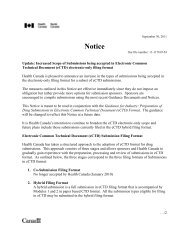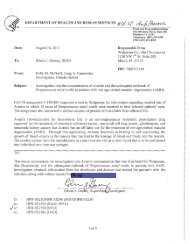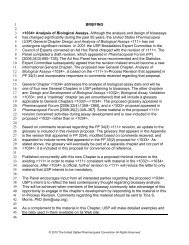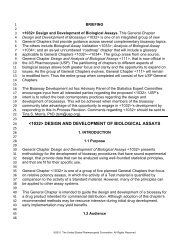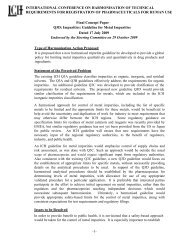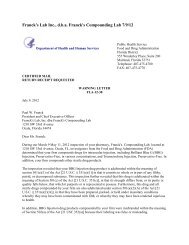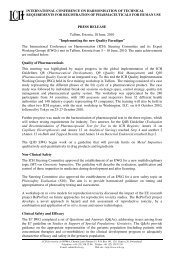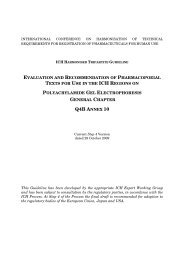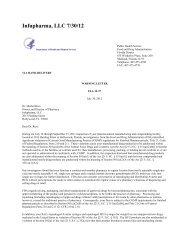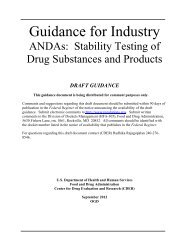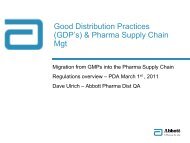BEPBA Bioassay Conference Agenda - IPQ
BEPBA Bioassay Conference Agenda - IPQ
BEPBA Bioassay Conference Agenda - IPQ
Create successful ePaper yourself
Turn your PDF publications into a flip-book with our unique Google optimized e-Paper software.
BEBPA’s 3rd Annual Biological Assay <strong>Conference</strong><br />
Main <strong>Conference</strong>, Day 2: 1 October, 2010<br />
8:00-8:05 Chairperson’s Opening Remarks<br />
Dr. Laureen Little, Principal Consultant, Quality Services<br />
8:05-9:00: Opening Address:<br />
Recent EU Regulatory Experiences with BioAssays<br />
Dr. Peter Richardson, Head of Biologicals, Quality of<br />
Medicines Sector, European Medicines Agency<br />
Neutralizing Antibody Assays<br />
9:00-9:45 A Novel One-Step BioAssay for the Quantification<br />
of Neutralizing Antibodies<br />
A unique one-step bioassay was developed that overcomes<br />
limitations of conventional cell-based assays. This technology<br />
allows both drug activity and anti-drug neutralizing antibodies<br />
(NAbs) to be quantified rapidly and precisely in the<br />
same sample simply by adding reporter cells. Reporter cells<br />
express a reporter gene under control of a drug-responsive<br />
promoter, and express the drug normalized relative to an<br />
internal standard. Assay results are independent of cell<br />
number or differences in cell viability.<br />
Dr. Michael Tovey, Director, Instit. Andre Lwoff, France.<br />
9:45-10:30 Development and Validation of a Difficult Neutralizing<br />
Antibody (NAB) Assay: A Case Study.<br />
We developed and validated a cell based assay for determining<br />
neutralizing antibodies (NAB) directed against a molecule with<br />
endocrine activity. The assay was developed based on a potency<br />
assay with a cAMP read out. Most critical parameters<br />
were low signal-to noise ratio, high variability, and a tremendous<br />
influence of the matrix. By optimizing assay conditions and parameters<br />
a satisfactory NAB assay was established, validated<br />
and implemented.<br />
Dr. Gisela Peraus, Bureco AG, Switzerland<br />
10:30—11:00: Break<br />
11:00-11:45 Dilutional Linearity (DL) for NAB Assays<br />
Neutralizing antibody (NAB) serological assays routinely proceed<br />
without assessing similarity among specimen doseresponse<br />
curves. This lack of similarity can manifest as specimen-specific<br />
dilution bias. Test samples typically have activities<br />
several folds wider than the dynamic range of the assay, which<br />
further narrows acceptable bias. These two features make DL<br />
assessment essential for NAb assays. The DL study documents<br />
sample effect dilution on assay precision and bias. Sources of<br />
error can be categorized into five distinct types. Care must be<br />
taken to measure and account for each.<br />
Dr. David Lansky, President, Precision <strong>Bioassay</strong>, USA<br />
Beyond Potency—Cell-based <strong>Bioassay</strong>s in Quality<br />
Session Chair: Dr. Nadine Ritter, Consultant, BCG, USA<br />
11:45-12:30 Modifications in Therapeutic MAb Products:<br />
Isoforms or Impurities?<br />
Therapeutic Mabs are complex molecules and are prone to several<br />
modifications during production process and storage. Potency<br />
assays play a key role in determining whether these modifications<br />
are impurities or product related isoforms. Real life<br />
case studies will be presented.<br />
Dr Venkat Mukku, Global Cellular Analytic Solutions US<br />
Three Ways to Register<br />
www.BEBPA.org Telephone: +1-916-729-0109<br />
12:30—1:30 Lunch<br />
1:30-2:15 Protein Microarrays in Combination with Cell<br />
Based <strong>Bioassay</strong>s are More Reliable for Stability Testing<br />
Stability a major concern for quality, efficacy and safety of therapeutic<br />
active monoclonal antibodies. Reliable and fast evaluation<br />
tools are required for screening during product development<br />
and ICH compliant stability testing. The combination of well accepted<br />
cell based bioassays, modern protein microarrays and<br />
classical structure characterization techniques allows a unique<br />
and comprehensive view on mAB degradation pathways and<br />
characteristics. Advantages and disadvantages of different analytical<br />
approaches as well as synergetic effects due to method<br />
combination will be presented.<br />
Dr. Katja Aschermann, Manager, Protagen AG, Germany<br />
Session Title: Hands On Session - Case Studies<br />
Session Chair: Dr. Jane Robinson, NIBSC, UK<br />
2:15-3:00 Preclinical Development of Nanobodies® : Challenges<br />
in Potency Assay Development<br />
Nanobodies® are a novel class of therapeutic proteins based<br />
on the smallest functional fragments of heavy chain antibodies,<br />
which occur naturally in the Camelidae family. This platform<br />
has lead to a wide range of Nanobody formats, including unique<br />
multivalent, biparatopic, and bispecific compounds. Such flexibility<br />
provides a challenge in the development of stability indicating<br />
potency assays. This case study discusses the development<br />
of various potency assays for release and stability testing. Examples<br />
demonstrate how assays were optimized to discriminate<br />
between the multivalent or biparatopic Nanobody formats and<br />
their monovalent analogues.<br />
Dr. Hans Ulrichts, Sr. Scientist, Ablynx, Belgium<br />
3:00-3:30 Poster Talks<br />
Back by popular demand! Two posters will be selected for 15<br />
minute presentations in the main conference. This is great opportunity<br />
for students and junior analysts to present.<br />
Presenters to be selected day 1 of the conference.<br />
3:30—4:00 Exhibit/Poster and Refreshment Break<br />
4:00-4:45 Development of a Whole Blood Cell Depletion<br />
Assay for Characterization of Therapeutic Antibodies<br />
Directed Against Lymphoid Targets<br />
Dr. Roger Grau, Novartis Biologics, Switzerland<br />
4:45-5:30 Case studies from India: Development of Cell<br />
Based Reporter Gene Assays for Biosimilars.<br />
<strong>Bioassay</strong>s are the only non-clinical tests that indicate a<br />
biosimilar product is biologically active. Cell based reporter<br />
gene assays are the benchmark to prove functional similarity<br />
of a biosimilar to the originator molecule. We present a case<br />
study on the development of an in vitro reporter gene assay<br />
using luciferase to determine the potency of a biosimilar<br />
erythropoietin (EPO).<br />
Rajeev Soni, President and COO, Premas Biotech<br />
Chairperson’s closing comments and selection on next<br />
year’s meeting venue<br />
5:45 <strong>Conference</strong> Adjourns<br />
Fax:1-916-729-2602



